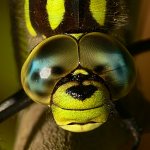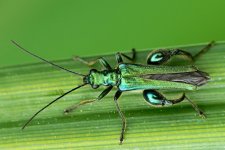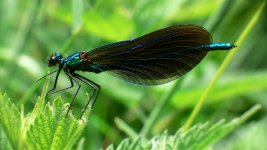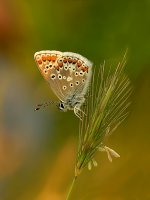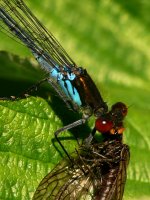-
Welcome to BirdForum, the internet's largest birding community with thousands of members from all over the world. The forums are dedicated to wild birds, birding, binoculars and equipment and all that goes with it.
Please register for an account to take part in the discussions in the forum, post your pictures in the gallery and more.
You are using an out of date browser. It may not display this or other websites correctly.
You should upgrade or use an alternative browser.
You should upgrade or use an alternative browser.
Help please (1 Viewer)
- Thread starter Freako
- Start date
More options
Who Replied?IanF
Moderator
An extension tube has no glass in it so the image doesn't degrade. The lens retains the same level of sharpness as with no tube fitted.
The only thing you lose is the amount of light entering the lens - usually around 1-stop but it does depend on the thicknes sof the extension tube. You'll still have full autofocus/expsoure - provided they're atuo tubes.
The benefit gained is a shorter minimum focus distance and a larger image size on the sensor.
I'd say give it a go.
The only thing you lose is the amount of light entering the lens - usually around 1-stop but it does depend on the thicknes sof the extension tube. You'll still have full autofocus/expsoure - provided they're atuo tubes.
The benefit gained is a shorter minimum focus distance and a larger image size on the sensor.
I'd say give it a go.
Freako
Well-known member
An extension tube has no glass in it so the image doesn't degrade. The lens retains the same level of sharpness as with no tube fitted.
The only thing you lose is the amount of light entering the lens - usually around 1-stop but it does depend on the thicknes sof the extension tube. You'll still have full autofocus/expsoure - provided they're atuo tubes.
The benefit gained is a shorter minimum focus distance and a larger image size on the sensor.
I'd say give it a go.
Thanks Ian, would the quality be as good as a dedicated macro lens?
IanF
Moderator
I'd say a macro lens is specially designed for the job so it should do the job better especially if you want true 1:1 or greater reproduction on the sensor.
It may also depend on the subject. Macro lenses are usually between 50mm-180mm which means you have to get really close to the subject - not ideal if you're just interested in living butterflies and dragonflies which mainly interest me.
I either use a 400mm lens or a 100-400mm zoom for close up photos which suits my purposes and I'm happy with the results.
If you want to get really close though and photograph the eye of a dragonfly then really a macro lens is the way to go.
It may also depend on the subject. Macro lenses are usually between 50mm-180mm which means you have to get really close to the subject - not ideal if you're just interested in living butterflies and dragonflies which mainly interest me.
I either use a 400mm lens or a 100-400mm zoom for close up photos which suits my purposes and I'm happy with the results.
If you want to get really close though and photograph the eye of a dragonfly then really a macro lens is the way to go.
SteveClifton
Well-known member
Mick, this depends what you want to shoot. Do you want to do proper macros (small insects, close-ups of a butterfly's or dragonfly's head) or just get closer to your subject? I don't know the very much about your lens, but would you say it was a very sharp lens?
Almost all true macros have very sharp optics, as macro pictures need to be sharp and crisp to look their best IMO.
If your lens is sharp to begin with then it will likely produce good close-ups, but no doubt a dedicated macro lens will be better if you want to spend the money. I bought a tube for my 100-400 zoom, but still bought a macro lens and it is definitely better.
Steve
edit: looks like Ian beat me to it, but we both said more or less the same thing
Almost all true macros have very sharp optics, as macro pictures need to be sharp and crisp to look their best IMO.
If your lens is sharp to begin with then it will likely produce good close-ups, but no doubt a dedicated macro lens will be better if you want to spend the money. I bought a tube for my 100-400 zoom, but still bought a macro lens and it is definitely better.
Steve
edit: looks like Ian beat me to it, but we both said more or less the same thing
Last edited:
Freako
Well-known member
Mick, this depends what you want to shoot. Do you want to do proper macros (small insects, close-ups of a butterfly's or dragonfly's head) or just get closer to your subject? I don't know the very much about your lens, but would you say it was a very sharp lens?
Almost all true macros have very sharp optics, as macro pictures need to be sharp and crisp to look their best IMO.
If your lens is sharp to begin with then it will likely produce good close-ups, but no doubt a dedicated macro lens will be better if you want to spend the money. I bought a tube for my 100-400 zoom, but still bought a macro lens and it is definitely better.
Steve
edit: looks like Ian beat me to it, but we both said more or less the same thing
Thanks both. I have the 100-400 and use it for my Dragon fly images, which are quite acceptable, but not so good with smaller Damsels. As I say I have the 70-300 doing nothing and was wondering if it would do closer, like Dragon fly heads etc. It's either that or trade it for a macro lens. If i did could you recommend one?
SteveClifton
Well-known member
Thanks both. I have the 100-400 and use it for my Dragon fly images, which are quite acceptable, but not so good with smaller Damsels. As I say I have the 70-300 doing nothing and was wondering if it would do closer, like Dragon fly heads etc. It's either that or trade it for a macro lens. If i did could you recommend one?
I find exactly the same with the 100-400 and Damsels. I think either the Sigma 150 or 180 would serve you well (I have the 180), but before you splash out take look at Walwyn's suggestion...(not sure about the working distance though?) Some dragons won't allow such a close approach as you seem to need with the Raynox adapters.
Last edited:
Freako
Well-known member
Before you go and spend oodles of cash on macro lens give the Raynox DCR250 or DCR150 a try. Check the entomology page on my website for othe images.
Thank you, very impressive.
Freako
Well-known member
I find exactly the same with the 100-400 and Damsels. I think either the Sigma 150 or 180 would serve you well (I have the 180), but before you splash out take look at Walwyn's suggestion...(not sure about the working distance though?) Some dragons won't allow such a close approach as you seem to need with the Raynox adapters.
Thanks Steve.
walwyn
Well-known member

With the Raynoxs you work close about 6-8 inches. Sometimes it can be challenging but I've yet to find an insect species that won't let you work close. Just don't cast a shadow over them |})|
The DCR150 is better for dragons, damsels, and butterflies as it doesn't give quite as much magnification. But the DCR250 is quite capable with these insects too.
The DCR150 is better for dragons, damsels, and butterflies as it doesn't give quite as much magnification. But the DCR250 is quite capable with these insects too.
Attachments
Smudger01
Enthusiastic Amateur
Have to agree with all said really, particularly walwyn... Most insects will let you get close as long as you move slow enough towards them. I use the Sigma 150mm + Tubes and like walwyn get very close to my subjects.. btw (I'm 6'-4" and approx 16 stone, and I manage to not scare them off) "most of the time anyway" :-O
James
I'm losing it!
As I say I have the 70-300 doing nothing
I could make you an offer for it.
James
walwyn
Well-known member

Walwyn's 10 point guide to photographing insects.
1. Some days you could have just stayed in.
2. There is always another day.
3. Just when you think that it is all hopeless magic happens.
4. Observe what it is doing. Many insects return to the same spot, you can wait for it/
5. Move in slowly take a couple of record shots you don't need to fill the frame.
6. Move in a bit more and start to increase magnification.
7. Don't cast a shadow.
8. Don't hit it with the lens and don't stumble into the bush.
9. Take plenty of shots.
10. Now you have got at least one useful shot, relax and move around the subject looking for better angles and backgrounds.
1. Some days you could have just stayed in.
2. There is always another day.
3. Just when you think that it is all hopeless magic happens.
4. Observe what it is doing. Many insects return to the same spot, you can wait for it/
5. Move in slowly take a couple of record shots you don't need to fill the frame.
6. Move in a bit more and start to increase magnification.
7. Don't cast a shadow.
8. Don't hit it with the lens and don't stumble into the bush.
9. Take plenty of shots.
10. Now you have got at least one useful shot, relax and move around the subject looking for better angles and backgrounds.
Freako
Well-known member
I could make you an offer for it.
James
If you did I would bare it in mind.
settings
Am interested in this thread as I have a canon 400D and 70-300mm lens. Primarily for bird photography but am also interested in butterflies and d'flies.
Have been using it with close up mode. Wondered if any of you with this sort of set up use this setting or any other?
Can't afford a macro lens at the moment and from some of the above posts good results can be achived with other lens.
So advice on settings etc would be most welcome.
Many thanks,
Hugh
Am interested in this thread as I have a canon 400D and 70-300mm lens. Primarily for bird photography but am also interested in butterflies and d'flies.
Have been using it with close up mode. Wondered if any of you with this sort of set up use this setting or any other?
Can't afford a macro lens at the moment and from some of the above posts good results can be achived with other lens.
So advice on settings etc would be most welcome.
Many thanks,
Hugh
walwyn
Well-known member

Try out one of the Raynox lens the DCR150 for larger insects the DCR250 for smaller ones, I have both but mainly use the 250. On the panasonic b ecause one is going from 43mm (raynox to 55 mm pana) you get vignetting at anything below 110 mm, I expect that will be around the same for most lenses, but they are excellent lens for field work.
Don't forget that,although reducing you to 'manual mode' a cheap set of extension tubes, coupled with a large zoom or telephoto, is an easy option for dragons and flutterbies. Just lets you focus a lot closer and the image quality is as good as the lens.
A cheap and very portable way to nab a few insect photo's if you are out taking birdy photo's and and see the chance to snap a sitting dragon.
For a bit more money, a 'budget' set of fully electronic extension tubes (55 squid, poland, ebay) do a fantastic job coupled with a tele or zoom, and, once again, 'stick in your pocket' portable.
A cheap and very portable way to nab a few insect photo's if you are out taking birdy photo's and and see the chance to snap a sitting dragon.
For a bit more money, a 'budget' set of fully electronic extension tubes (55 squid, poland, ebay) do a fantastic job coupled with a tele or zoom, and, once again, 'stick in your pocket' portable.
I do have a dedicated macro lens - Sigma 105mm EX DG - and love it. It does like a close working distance though. For larger insects, Dragonflies, butterflies etc, I use a 300mm F4 Telephoto which has produced some of the best Dragonfly photos I have ever taken. The longer focal length allows an increased working distance but has a minimum focal distance of about 1 metre.
Another trick, if using a shorter focal length lens, is to get out early while temperatures are still lower and the insects are less active, allowing a closer approach.
Another trick, if using a shorter focal length lens, is to get out early while temperatures are still lower and the insects are less active, allowing a closer approach.
Users who are viewing this thread
Total: 2 (members: 0, guests: 2)




